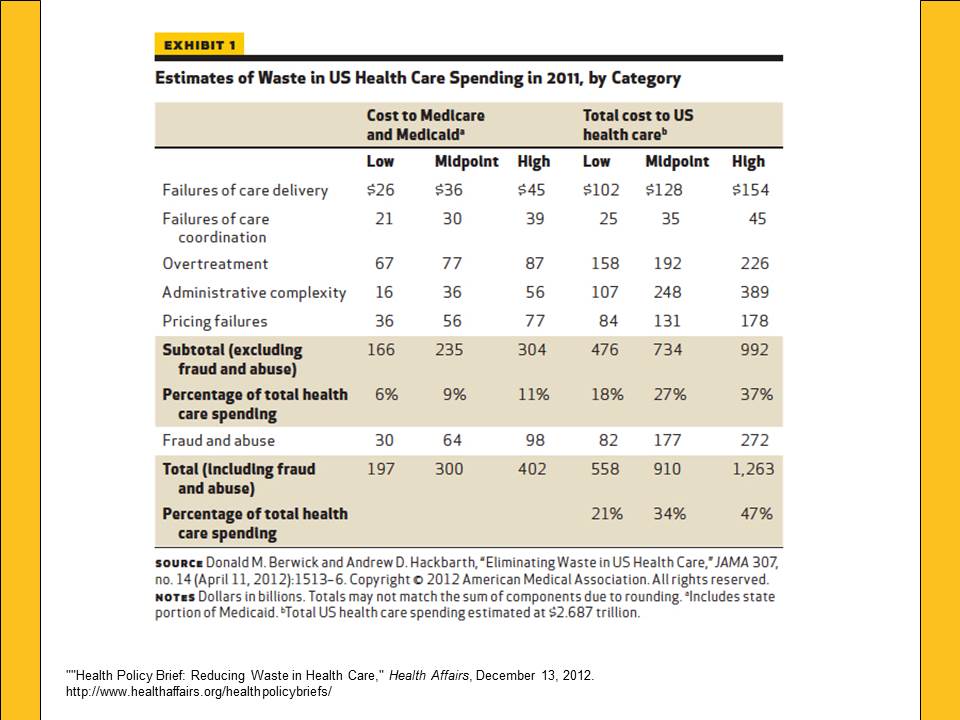Health Care Could Save Billions by Reducing Waste in Six Key Areas

Health Care Could Save Billions by Reducing Waste in Six Key Areas
The U.S. health care system could save hundreds of billions of dollars each year in public and private health care expenditures by adopting strategies to reduce waste in six key categories that are major drivers of health care costs. That’s the conclusion of an article(jama.ama-assn.org) by former CMS Administrator Donald Berwick, M.D., and Andrew Hackbarth, M.Phil., an assistant policy analyst at the RAND Corp., inJAMA: The Journal of the American Medical Association.
“In just six categories of waste — overtreatment, failures of care coordination, failures in execution of care processes, administrative complexity, pricing failures, and fraud and abuse — the sum of the lowest available estimates exceeds 20 percent of total health care expenditures,” say the authors. “The actual total may be far greater. The savings potentially achievable from systematic, comprehensive and cooperative pursuit of even a fractional reduction in waste are far higher than from more direct and blunter cuts in care and coverage.”
The authors point out that health care costs consumed nearly 18 percent of the gross domestic product in 2011, a figure that is expected to climb to 20 percent by 2020. “No matter how polarized politics in the United States have become, nearly everyone agrees that health care costs are unsustainable.”
In addition, the nation’s growing health care costs negatively affect other parts of the U.S. economy. These costs erode wages and undermine U.S. competitiveness in the global economy, according to the article. Rising health care costs also reduce resources for needed government programs.
Berwick and Hackbarth note that obtaining savings by cutting spending in health care may be seen as the most obvious remedy, but cutting waste instead of spending actually is a basic survival strategy in most industries today. The goal is to retain “processes, products and services that actually help consumers and systematically remove the elements of work that do not,” say the two authors.
In identifying the six areas for waste reduction, Berwick and Hackbarth define the waste associated with each category and estimate the cost savings that could occur by improving processes and care.
Those six areas for waste reduction and their associated costs for 2011 are:
- delivery-of-care failures resulted in an estimated cost of between $102 billion and $154 billion,
- care-coordination failures accounted for $25 to $45 billion in wasteful spending,
- overtreatment represented between $158 and $226 billion,
- administrative complexity resulted in wasteful spending of between $107 and $339 billion,
- pricing failures cost the United States between $84 and $178 billion, and
- fraud and abuse contributed between $82 billion and $272 billion in wasteful spending.
“If the United States is to reconstruct a health care industry that is both affordable and relentlessly focused on meeting the needs of every single patient and family, waste reduction (that is, the removal of nonvalue-added practices in all their forms) is the best strategy by far,” the authors write.
Content Courtesy of: American Academy of Family Practitioners
NEED ASSISTANCE WITH RECYCLING?
WE SPECIALIZE IN RECYCLING AND WASTE REDUCTION
OUR OFFICE SERVES BUSINESSES AND ORGANIZATIONS
BY REDUCING WASTE AND DISPOSAL COSTS
CONTACT 800-441-7949
Posted in: Uncategorized
Leave a Comment (0) ↓

